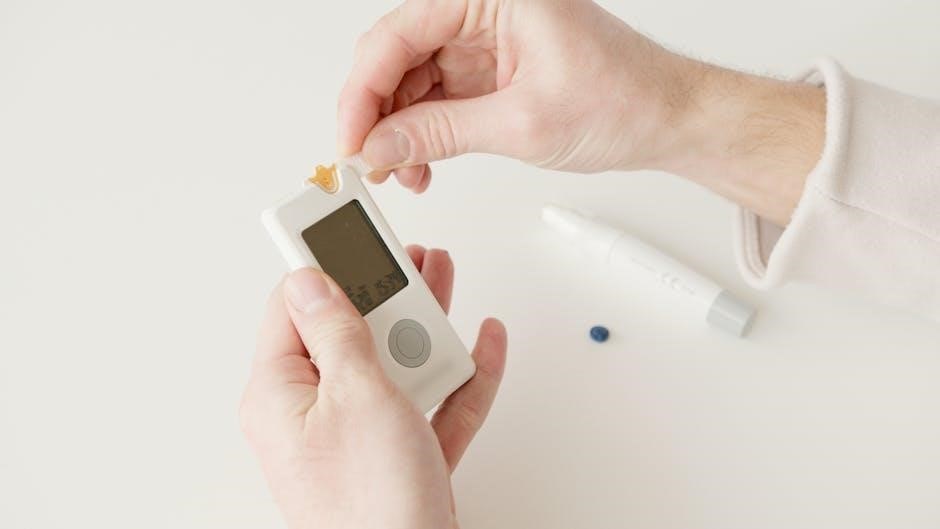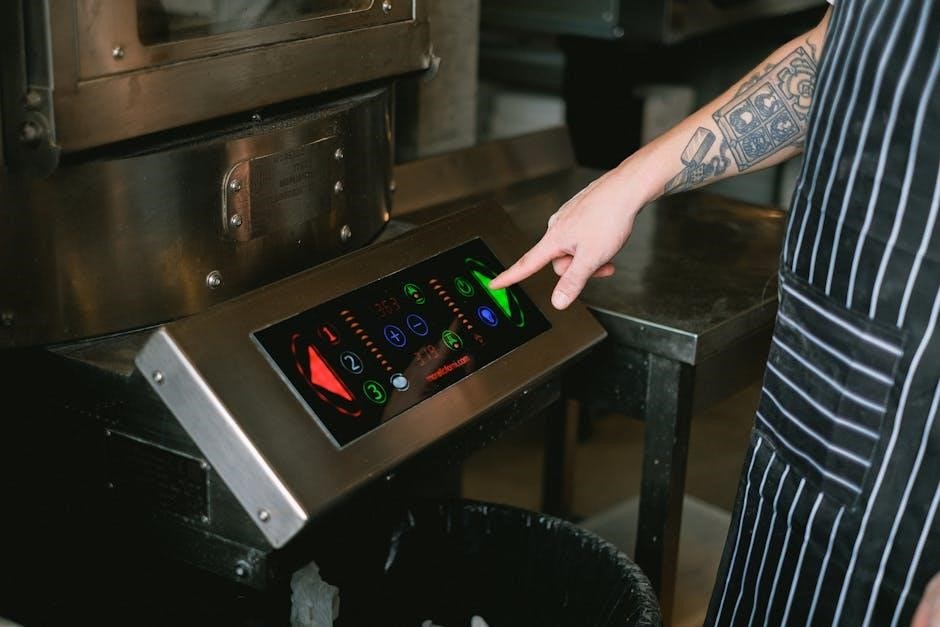LPILE is a software program designed for analyzing deep foundations under lateral loads, utilizing the p-y method to model nonlinear soil resistance and ensure accurate pile design․
1․1 Overview of LPILE Software
LPILE is a comprehensive software tool for analyzing deep foundations under lateral loads․ It employs the p-y method to model nonlinear soil behavior, enabling accurate predictions of pile deflection, rotation, and moment․ Designed for geotechnical engineers, LPILE supports the analysis of single piles and offers a user-friendly interface for inputting pile properties, soil profiles, and load cases․ Its advanced capabilities include ultimate-moment capacity calculation and rebar arrangement design, making it a robust solution for pile design and analysis․
1․2 History and Development of LPILE
LPILE was first developed in the early 2000s as a specialized tool for analyzing deep foundations under lateral loads․ Over the years, it has evolved through numerous updates, with significant releases in 2012, 2013, and 2018․ Each version introduced enhanced features, such as improved p-y method capabilities and better integration with other software․ Today, LPILE is widely recognized as a standard tool in geotechnical engineering, continuously updated to meet advancing industry demands and standards․
1;3 Purpose and Scope of the User Manual
This manual provides a comprehensive guide to using LPILE, covering installation, interface navigation, input parameters, and analysis execution․ It serves as a reference for engineers to understand software capabilities, troubleshoot issues, and optimize design workflows․ The manual ensures users can fully utilize LPILE’s features for accurate pile analysis and design, fostering efficiency and precision in geotechnical projects․

System Requirements and Installation
LPILE requires compatible hardware and software, including supported operating systems, sufficient RAM, and disk space․ Installation involves downloading, running the installer, and activating the license․
2․1 Hardware and Software Requirements
LPILE requires a compatible operating system, such as Windows 10 or later, with a minimum of 4 GB RAM and 2 GB of available disk space․ A multi-core processor is recommended for efficient performance․ The software is designed to run on 64-bit systems, ensuring optimal functionality and compatibility with modern hardware configurations․ Meeting these requirements ensures smooth installation and operation of LPILE․
2․2 Installation Process and Licensing
The installation of LPILE involves downloading the software from the official website and following the step-by-step installer instructions․ Upon completion, users must activate the program using a valid license key, which can be purchased from authorized distributors․ The licensing agreement allows the software to be used simultaneously by multiple users, provided the number of licenses purchased is not exceeded․ Proper activation ensures full access to all features and functionalities․
2․3 System Compatibility and Updates
LPILE is compatible with Windows 10 and 11 (64-bit versions) and requires a minimum of 4GB RAM for optimal performance․ Regular software updates are essential for maintaining functionality and security․ Users can access updates via the internal updater tool or by downloading patches from the official website․ Ensuring system requirements are met before updating is recommended to avoid compatibility issues․ Always backup data before performing updates․

User Interface and Navigation
LPILE features a user-friendly interface with intuitive menus, toolbars, and customizable options, enabling efficient navigation and workflow optimization for engineers and analysts․
3․1 Layout and Organization of the Interface
LPILE’s interface is organized into logical sections, including input parameters, analysis settings, and result visualization․ The layout is designed for efficiency, with clear tabs, dropdown menus, and buttons․ Users can easily navigate between sections, such as pile properties, soil profiles, and load cases, ensuring a streamlined workflow․ The interface also provides quick access to help resources and customization options, enhancing user productivity․
3․2 Menu Options and Toolbars
LPILE features a comprehensive menu system with options for file management, analysis settings, and result viewing․ Toolbars provide quick access to frequently used commands, such as data input, calculation execution, and graph generation․ Contextual menus offer additional functionality, allowing users to customize displays and manage projects efficiently․ These tools enhance workflow by streamlining tasks and reducing navigation time, making the software intuitive and user-friendly․
3․3 Customization Options for User Efficiency
LPILE offers extensive customization options to enhance user efficiency․ Users can tailor the interface, including toolbars, menus, and display settings, to suit their workflow preferences․ Customizable templates and user-defined parameters enable streamlined input and analysis processes․ Additionally, the software allows for personalized defaults, reducing repetitive tasks and saving time․ These features ensure a more intuitive and adaptable experience, catering to individual user needs and improving overall productivity․

Technical Background and Methodology
LPILE employs the p-y method for lateral load analysis, incorporating nonlinear soil resistance models to determine ultimate-moment capacity and ensure accurate deep foundation designs․
4․1 The p-y Method for Lateral Load Analysis
The p-y method in LPILE models soil resistance as a series of nonlinear springs along the pile, providing accurate predictions of deflection, rotation, and shear force under lateral loads․ This approach accounts for soil nonlinearity and stress-strain behavior, enabling precise analysis of deep foundation responses to various loading conditions;
4․2 Nonlinear Soil Resistance Modeling
LPILE incorporates advanced nonlinear soil resistance modeling to simulate real soil behavior under lateral loads․ The software uses soil curves to represent stiffness and strength variations, capturing the progression of soil failure and plasticity․ This approach ensures accurate prediction of pile response, including deflection and moment distribution, enhancing the reliability of geotechnical designs in complex soil conditions․
4․3 Ultimate-Moment Capacity Calculation
LPILE calculates the ultimate-moment capacity of pile sections, ensuring safe and efficient design․ The software evaluates cross-sectional properties and material strengths, incorporating rebar arrangement details to determine maximum bending capacity․ This feature helps engineers verify structural integrity under extreme loading conditions, providing critical data for compliance with design standards and optimization of pile dimensions and reinforcement․

Input Parameters and Data Requirements
LPILE requires precise input parameters, including pile properties, soil profiles, and load cases, ensuring accurate analysis and design of deep foundations under lateral loads․
5․1 Pile Properties and Section Details
Accurate pile properties, including section dimensions, material stiffness, and reinforcement details, are essential for LPILE analysis․ These inputs define the structural behavior of the pile under lateral loads, ensuring realistic simulations and design results․ Proper specification of these parameters is critical for obtaining reliable outcomes in the analysis of deep foundation systems․
5․2 Soil Profile and Material Parameters
Soil profile and material parameters are critical inputs in LPILE, defining the ground’s resistance behavior․ Layers with varying stiffness, strength, and nonlinear properties must be accurately specified․ These parameters influence the p-y curves, affecting the pile’s response under lateral loads․ Detailed soil data ensures precise analysis and reliable design recommendations for deep foundations․
5․3 Load Cases and Boundary Conditions
Load cases and boundary conditions in LPILE define the external forces and constraints acting on the pile․ These include lateral loads, moments, and soil reactions․ Boundary conditions specify fixed or free head constraints, influencing the analysis․ Accurate load case definitions ensure realistic simulations, enabling precise evaluation of pile behavior under various scenarios for reliable design and safety assessments․
Analysis Process and Execution
LPILE’s analysis process executes the p-y method to model nonlinear soil resistance and calculate ultimate-moment capacity, providing critical insights for pile design and safety․
6․1 Step-by-Step Analysis Procedure
LPILE’s analysis begins with inputting pile properties, soil profiles, and load cases․ Users define boundary conditions and material parameters, followed by initiating the p-y method simulation․ The software computes bending moments, shear forces, and deflections iteratively․ Real-time monitoring is available through progress tracking․ Upon completion, results are displayed for interpretation, enabling engineers to assess pile performance and design compliance efficiently․
6․2 Running the Analysis and Monitoring Progress
Once input parameters are set, initiate the analysis through LPILE’s interface․ A progress bar tracks computation, while real-time updates display iterative results․ The software validates calculations, ensuring convergence․ Engineers can monitor bending moments, shear forces, and deflections dynamically․ Alerts notify of anomalies, allowing prompt adjustments․ The process ensures transparency and control, enabling efficient troubleshooting and accurate results․
6․3 Interpretation of Analysis Results
Upon completing the analysis, LPILE generates detailed results, including bending moments, shear forces, and deflections along the pile․ Users can review these outputs to assess the structural integrity and behavior under applied loads․ Graphical representations simplify understanding, while numerical data provides precise values for design validation․ Engineers should verify that results meet safety margins and design criteria, ensuring compliance with engineering standards․

Output and Results Interpretation
LPILE provides comprehensive output files, including numerical and graphical representations of analysis results․ These outputs enable engineers to interpret pile behavior, verify design criteria, and optimize solutions efficiently․
7․1 Understanding Output Files and Formats
LPILE generates detailed output files in various formats, including text and graphical representations․ These files provide a comprehensive overview of pile behavior, such as displacement, shear force, and bending moment along the pile length; Engineers can interpret these results to verify design compliance and make informed decisions․ The output is structured for clarity, allowing users to easily access and analyze critical data points efficiently․
7․2 Graphical Representation of Results
LPILE provides visual graphs that illustrate key results like load-displacement curves, bending moment diagrams, and shear force distributions․ These graphs help users quickly grasp complex data, facilitating better understanding and decision-making․ Engineers can customize plots to focus on specific parameters, enhancing analysis efficiency and ensuring accurate interpretations of pile performance under various load conditions․
7․3 Key Parameters and Design Recommendations
LPILE’s output highlights critical parameters such as ultimate moment capacity, maximum displacement, and soil resistance․ Design recommendations are provided to optimize pile sections and rebar arrangements, ensuring structural integrity․ Engineers can use these insights to refine designs, meet safety standards, and improve construction efficiency, making LPILE an essential tool for reliable and cost-effective deep foundation analysis․

Design and Analysis Capabilities
LPILE offers advanced design optimization for pile sections, calculating ultimate-moment capacity and providing detailed rebar arrangement recommendations, along with enhanced analysis features for complex scenarios․
8․1 Design of Pile Sections for Ultimate Capacity
LPILE enables precise design of pile sections by calculating ultimate-moment capacity, ensuring structural integrity under lateral loads․ It incorporates nonlinear soil modeling for accurate load-resistance factored design, optimizing steel reinforcement and cross-sectional dimensions for efficient and safe pile performance․
8․2 Rebar Arrangement and Detailing
LPILE Plus provides detailed rebar arrangement recommendations, optimizing reinforcement placement for strength and durability․ The software offers design guidance for spacing, bar sizes, and cover requirements, ensuring compliance with structural codes and enhancing constructability while maintaining cost efficiency and safety in pile construction․
8․3 Advanced Analysis Options and Features
LPILE offers advanced analysis capabilities, including dynamic response assessment for time-dependent behavior and 3D modeling of complex soil profiles․ These features enable engineers to handle intricate pile designs and soil-structure interactions with precision, ensuring robust and accurate results for challenging engineering scenarios․

Advanced Features and Applications
LPILE includes advanced features like dynamic analysis, 3D modeling of complex soil profiles, and integration with other software tools, enhancing its versatility for sophisticated engineering applications․
9․1 Dynamic Analysis and Time-Dependent Behavior
LPILE offers dynamic analysis capabilities, enabling users to assess time-dependent effects on pile behavior under varying loads․ This feature is crucial for understanding long-term structural integrity and soil interaction, ensuring designs account for temporal changes in soil resistance and pile response over time․
9․2 3D Modeling and Complex Soil Profiles
LPILE supports advanced 3D modeling, allowing users to simulate complex soil profiles and layered soil conditions․ This capability ensures precise analysis of pile behavior under diverse soil structures, enhancing design accuracy and reliability for real-world applications with varying geological conditions․
9․3 Integration with Other Software Tools
LPILE seamlessly integrates with other engineering software, enabling data exchange and enhancing workflow efficiency․ Compatibility with programs like StormCAD and AutoCAD allows for comprehensive project management, while its interoperability with Inventor 2022-2018 ensures accurate design and analysis synchronization across platforms, streamlining the engineering process from concept to completion․

Troubleshooting and Common Issues
LPILE users may encounter issues like software compatibility problems or analysis errors․ Troubleshooting guides and error handling tips are provided to resolve common difficulties efficiently․
10․1 Common Errors and Solutions
Common errors in LPILE include input format issues, software compatibility problems, and licensing activation failures; Solutions involve verifying data accuracy, updating software versions, and contacting technical support for assistance․ Users should also ensure proper system requirements are met to avoid operational difficulties․ Referencing the official manual or online resources can provide detailed troubleshooting guides for specific error messages and optimization tips․
10;2 Debugging and Error Handling
Debugging in LPILE involves reviewing input files for discrepancies and utilizing built-in validation tools to identify errors․ Error handling features provide detailed messages, guiding users to resolve issues such as invalid soil parameters or incorrect pile section details․ Regular software updates often include bug fixes, improving stability and user experience․ Proper debugging ensures accurate analysis results and enhances overall productivity․
10․3 Performance Optimization Tips
To optimize LPILE’s performance, simplify complex models by reducing unnecessary details․ Use compatible hardware and ensure software updates are installed․ Regularly clean temporary files and close unused applications to free memory․ Utilize default settings for soil parameters unless specific data is required․ Avoid overly detailed soil profiles and leverage built-in tools for efficient data input․ These practices enhance speed and reliability for smoother analysis execution․

User Manual and Technical Support
The official LPILE user manual provides detailed guidance for effective software utilization, while technical support is available for troubleshooting and optimizing analysis processes efficiently․
11․1 Accessing the Official User Manual
The official LPILE user manual is accessible via the Ensoft website or through the software installation package․ It includes comprehensive guides, tutorials, and reference materials to assist users in mastering the program’s capabilities, ensuring efficient analysis of deep foundations under lateral loads․ Regular updates are provided to reflect new features and methodologies․
11․2 Online Resources and Tutorials
Ensoft provides extensive online resources, including tutorials, webinars, and documentation, to help users optimize LPILE․ These materials cover installation, analysis techniques, and troubleshooting․ Users can access these resources through the official website or within the software interface, enhancing their proficiency in performing lateral load analysis and pile design efficiently․
11․3 Contacting Technical Support
For technical assistance, users can contact Ensoft’s support team via email, phone, or through the official website․ The support team is available to address software-related inquiries, troubleshooting, and technical issues․ Registered users can access priority support, ensuring timely resolution of problems․ Additionally, Ensoft provides a comprehensive user manual and technical manual for self-assisted troubleshooting and software utilization․
LPILE is a powerful tool for analyzing deep foundations, offering ease of use and robust analysis capabilities․ Future developments will focus on enhancing 3D modeling and software integration․
12․1 Summary of Key Features and Benefits
LPILE offers advanced capabilities for analyzing deep foundations under lateral loads, with dynamic analysis, 3D modeling, and nonlinear soil resistance features․ It supports ultimate-moment capacity calculations and rebar detailing, ensuring efficient design․ The software integrates seamlessly with other tools, providing comprehensive solutions for engineers․ Regular updates enhance functionality, making it a reliable choice for geotechnical applications and pile design optimization․
12․2 Future Updates and Enhancements
Future updates aim to expand LPILE’s capabilities, incorporating advanced soil models and improved 3D analysis tools․ Enhanced integration with other software is planned, along with user interface improvements for better workflow efficiency․ Additionally, new features for dynamic and time-dependent behavior analysis are expected, ensuring LPILE remains a cutting-edge solution for geotechnical engineers and researchers in pile design and analysis․
12․3 Final Thoughts on Using LPILE
LPILE stands as an indispensable tool for geotechnical engineers, offering precise analysis and design capabilities for deep foundations․ Its user-friendly interface and robust features make it a preferred choice for both novices and experts․ By leveraging advanced methodologies, LPILE ensures reliable results, aiding in the creation of safe and efficient pile designs that meet modern engineering standards and challenges․